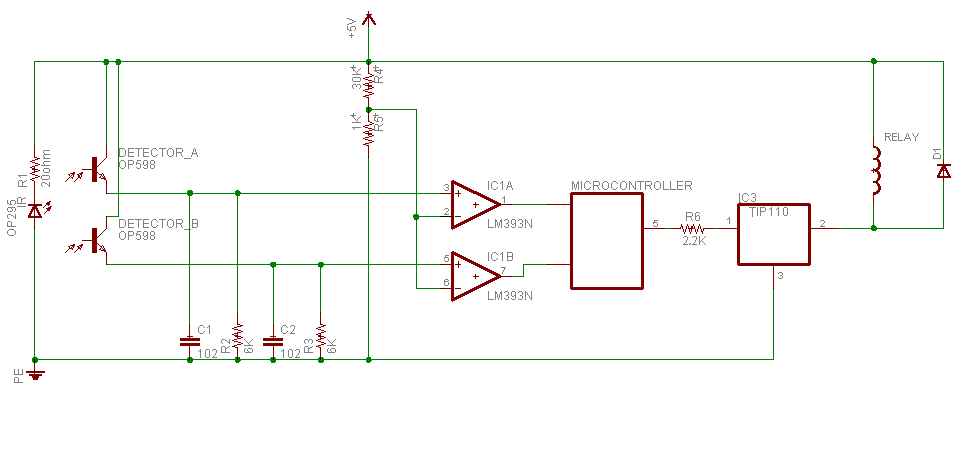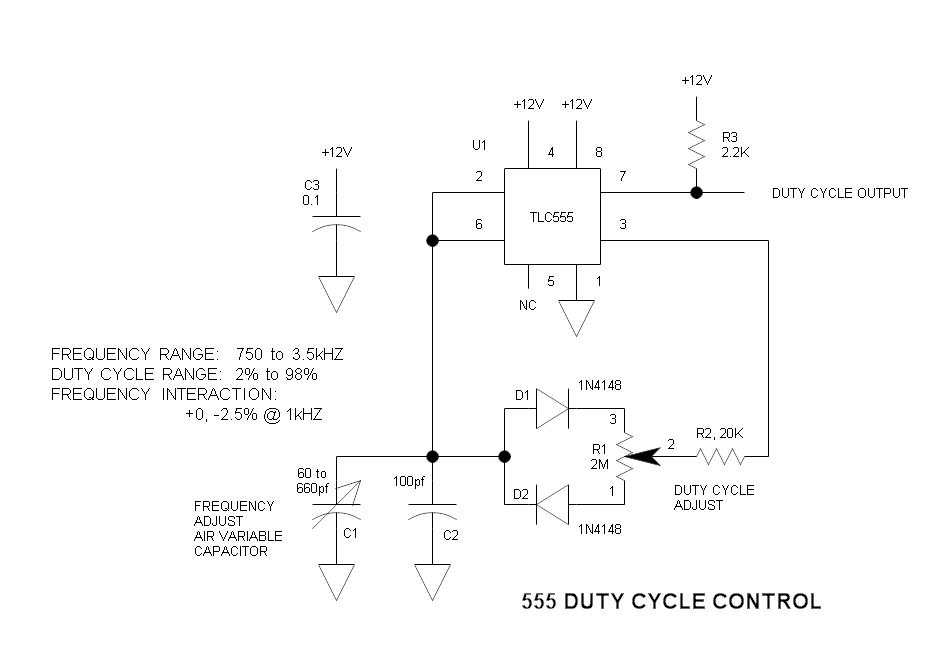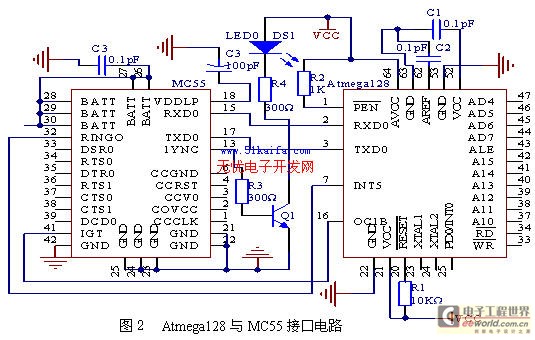
Light Control System (OP295)

Sensing unit consists of infrared emitter OP295 to produce the infrared beam, and two detectors in front of the emitter to detect the infrared beam OP598. Since the main idea in this device is to know person direction; and so, to get this approach, we have to use two pieces of infrared detectors in order to identify the direction of the person. When the infrared beam becomes broken due to any body, the output signals from these detectors will be changed in a unique sequence. The controller will identify the direction of the person by analyzing these signals as shown in the table at right "from 1 to 5 passed IN, 5 to 1 passed OUT". Since detectors output signals are analogue while the controller can only process digital signals, these signals must be converted to digital through the analogue comparator LM393. The controller will increase the number of persons inside the room by one, or decrease it by one when the appropriate sequence of signals has occurred. If this number is greater than zero, the light will be turned on; otherwise, it will be turned off. After this, the controller will stop scanning sensors for one second to allow the whole body to pass. Sensors circuit is so sensitive in Light Control System, that means any external noise or any small variation in voltage will change the sensors circuit status. While these signals are changing due to these reasons, the microcontroller will assume that someone has passed in front of the sensor and thus a fault will occur. In order to solve this problem, soft and hard components "capacitors" have been used to make the Light Control System stable as much as possible. A soft component is an algorithm in the control code to separate the noise signals from the real signals. If a camcorder or a mobile phone camera is used, the infrared light can be seen by pointing the infrared emitter at the camera; the infrared light will be visible in the viewfinder. If a remote is pointed at the camera and a button is pushed, the flashing light can be observed.
The sensing unit employs an infrared emitter, specifically the OP295, which generates an infrared beam directed towards two OP598 infrared detectors. These detectors are strategically positioned to ascertain the direction of a person approaching the sensing unit. The fundamental operation relies on the interruption of the infrared beam, which occurs when a person passes through the detection zone. This interruption results in a distinct alteration of output signals from the detectors, which are processed by a controller.
The controller, typically a microcontroller, is programmed to interpret the sequence of signals produced by the detectors. The table referenced indicates the expected signal transitions for detecting entry and exit movements—signals transitioning from 1 to 5 indicate entry, while transitions from 5 to 1 indicate exit. Given that the output from the infrared detectors is in analog form, it is essential to utilize an analog comparator, such as the LM393, to convert these signals into digital format suitable for processing by the microcontroller.
Upon processing the signals, the controller increments or decrements a count of individuals within the monitored space. If the count exceeds zero, a connected lighting system is activated; conversely, the lights are deactivated when the count returns to zero. To ensure accurate detection, the controller pauses sensor scanning for one second after detecting a passage, allowing sufficient time for the individual to clear the detection area.
The sensitivity of the sensor circuit is a critical factor in the performance of the light control system. External noise or minor fluctuations in voltage can inadvertently trigger false detections. To mitigate this issue, both hardware and software solutions are implemented. Capacitors serve as hardware components to filter out noise, while the control algorithm includes logic to distinguish between genuine signals and noise, thus enhancing the reliability of the system.
For practical demonstration, the infrared emitter can be visually confirmed using a camcorder or mobile phone camera, which can detect infrared light. When the emitter is activated, its light will be visible through the camera's viewfinder, illustrating the operational principle of the device.Sensing unit consists of infrared emitter OP295 to produce the infrared beam, & two detectors in front of the emitter to detect the infrared beam OP598. Since the main idea in this device is to know person direction; and so, to get this approach, we have to use tow pieces of infrared detector in order to identify the direction of the person.
When Infrared beam become brokendue to any body, the output signals from these detectors will be changed in unique sequence. Controller will identify the direction of the person by analyzing these signals as shown in the table at right "from 1 to 5 passed IN, 5 to 1 passed OUT"
Since detectors output signals are analogue while the controller can only process digital signals, these signals must be converted to digital through the analogue comparator LM393. Controller will increase the number of the persons in side the room by one, or decrease it by one when the appropriate sequence of signals have occurred.
If this number is greater than zero, light will be turned on otherwise it turned off. After this, controller will stop scan sensors for one second to allow the whole body to pass. Fig 3 describe the whole algorithm Sensors circuit is so sensitive in Light Control System, that mean any external noise or any small variation in voltage will change the sensors circuit status. While these signals are changing due to these reasons, microcontroller will assume that some one pass in front of sensor and so a fault will occur.
In order to solve this problem I have used soft and hard components "capacitors" to make Light Control System stable as much as possible. A soft component is an algorithm in the control code to separate the noises signals from the real signals.
If you have a camcorder, or just a camera mobile phone, you can see the infrared light! Just point the infrared emitter at the camera then you will be able to see the infrared light in the viewfinder. If you point your remote at the camera and push a button, you will see flashing light! 🔗 External reference
The sensing unit employs an infrared emitter, specifically the OP295, which generates an infrared beam directed towards two OP598 infrared detectors. These detectors are strategically positioned to ascertain the direction of a person approaching the sensing unit. The fundamental operation relies on the interruption of the infrared beam, which occurs when a person passes through the detection zone. This interruption results in a distinct alteration of output signals from the detectors, which are processed by a controller.
The controller, typically a microcontroller, is programmed to interpret the sequence of signals produced by the detectors. The table referenced indicates the expected signal transitions for detecting entry and exit movements—signals transitioning from 1 to 5 indicate entry, while transitions from 5 to 1 indicate exit. Given that the output from the infrared detectors is in analog form, it is essential to utilize an analog comparator, such as the LM393, to convert these signals into digital format suitable for processing by the microcontroller.
Upon processing the signals, the controller increments or decrements a count of individuals within the monitored space. If the count exceeds zero, a connected lighting system is activated; conversely, the lights are deactivated when the count returns to zero. To ensure accurate detection, the controller pauses sensor scanning for one second after detecting a passage, allowing sufficient time for the individual to clear the detection area.
The sensitivity of the sensor circuit is a critical factor in the performance of the light control system. External noise or minor fluctuations in voltage can inadvertently trigger false detections. To mitigate this issue, both hardware and software solutions are implemented. Capacitors serve as hardware components to filter out noise, while the control algorithm includes logic to distinguish between genuine signals and noise, thus enhancing the reliability of the system.
For practical demonstration, the infrared emitter can be visually confirmed using a camcorder or mobile phone camera, which can detect infrared light. When the emitter is activated, its light will be visible through the camera's viewfinder, illustrating the operational principle of the device.Sensing unit consists of infrared emitter OP295 to produce the infrared beam, & two detectors in front of the emitter to detect the infrared beam OP598. Since the main idea in this device is to know person direction; and so, to get this approach, we have to use tow pieces of infrared detector in order to identify the direction of the person.
When Infrared beam become brokendue to any body, the output signals from these detectors will be changed in unique sequence. Controller will identify the direction of the person by analyzing these signals as shown in the table at right "from 1 to 5 passed IN, 5 to 1 passed OUT"
Since detectors output signals are analogue while the controller can only process digital signals, these signals must be converted to digital through the analogue comparator LM393. Controller will increase the number of the persons in side the room by one, or decrease it by one when the appropriate sequence of signals have occurred.
If this number is greater than zero, light will be turned on otherwise it turned off. After this, controller will stop scan sensors for one second to allow the whole body to pass. Fig 3 describe the whole algorithm Sensors circuit is so sensitive in Light Control System, that mean any external noise or any small variation in voltage will change the sensors circuit status. While these signals are changing due to these reasons, microcontroller will assume that some one pass in front of sensor and so a fault will occur.
In order to solve this problem I have used soft and hard components "capacitors" to make Light Control System stable as much as possible. A soft component is an algorithm in the control code to separate the noises signals from the real signals.
If you have a camcorder, or just a camera mobile phone, you can see the infrared light! Just point the infrared emitter at the camera then you will be able to see the infrared light in the viewfinder. If you point your remote at the camera and push a button, you will see flashing light! 🔗 External reference





